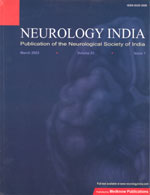
|
Neurology India
Medknow Publications on behalf of the Neurological Society of India
ISSN: 0028-3886
EISSN: 0028-3886
Vol. 58, No. 2, 2010, pp. 225-229
|
 Bioline Code: ni10060
Bioline Code: ni10060
Full paper language: English
Document type: Research Article
Document available free of charge
|
|
|
Neurology India, Vol. 58, No. 2, 2010, pp. 225-229
| en |
Intrasinus thrombolysis in cerebral venous sinus thrombosis: Single-center experience in 19 patients
Kumar, Sudhir; Rajshekher, Garikapati; Reddy, Chenna Rajesh; Venkateswarlu, J. & Prabhakar, Subhashini
Abstract
Background: Evidence from small case series suggests that the intrasinus thrombolysis (IST) is relatively safe and effective in rapid recanalization of thrombosed sinuses and reversal of neurological deficits in patients with cerebral venous and sinus thrombosis (CVST) However, in the absence of randomized controlled trials, the exact role of IST in the management of CVST is unclear,
Aim: To study the safety and efficacy of IST in patients with CVST.
Materials and Methods: Adult patients with CVST who received IST during a two-year period (January 2003-December 2004) were included. Data regarding demographic, clinical and radiological features were collected. Follow-up data were obtained at 3-6 months. Magnetic resonance venography (MRV) was repeated to assess the recanalisation of venous sinuses.
Results: Nineteen patients (11 women) with a mean age of 32 years (range 17-46 years) received IST during the study period. Common clinical features at presentation included headache, altered consciousness and seizures. Indications for thrombolysis included clinical deterioration despite adequate anticoagulation and rapid worsening of consciousness or neurological deficits. Thirteen patients (68%) had dural sinus thrombosis alone and six others had coexisting deep venous system involvement. Venous infarcts were present in 13 patients. At discharge, 15 patients (79%) had good outcome and were either asymptomatic or had only mild deficits and were independent for activities of daily living. Three patients died and one survived with severe neurological deficits. Angiographic improvement (as per digital subtraction angiography) was noted in 12 patients (complete in five and partial in seven) and seven patients had poor or no recanalization of the involved venous sinuses. At a median follow-up of 6.3 months, 14 (74%) patients had no or mild neurological deficits.
Conclusion: IST is safe and effective in patients with CVST who fail to respond to conventional medical treatment. However, the subgroup of patients who are likely to benefit the most from this procedure is not clear from our data. Large randomized controlled trials are required to further clarify this issue.
Keywords
Cerebral venous thrombosis, efficacy, outcome, thrombolysis, safety, urokinase
|
| |
© Copyright 2010 Neurology India.
Alternative site location: http://www.neurologyindia.com
|
|
